Roden 1/48 Gloster
Gladiator Mk. I By Jim Schubert | 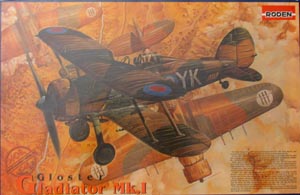
| History The Gladiator came into existence because it was a safe bet, at the time, by the Air Ministry on a fairly conservative evolutionary development of well known biplane principles already demonstrated by the Gloster Gauntlet and it was being offered by a stable firm with a good reputation and a brilliant chief engineer, H. P. Folland. At that time the Hurricane - itself a bit of a conservative hedge - and the Spitfire were still only paper airplanes with unknown lead times to production and delivery. Knowing the world was on the brink of war and that the monoplanes might not be available in time, drove the Air Ministry to order the Gladiator into production as a stop-gap effort even though the design was already obsolescent. The Gladiator shows clearly its descent from the precedent, tried and true, Gloster Gauntlet. The first of 747* Gladiators, K6129, was delivered to the RAF on February 16, 1937 and the last sometime in late 1938; a production run of only about a year and a half. Gloster executed contracts for Gladiator deliveries to the RAF, the FAA, Belgium, China, Eire, Greece, Iraq, Latvia, Lithuania, Norway, Portugal and Sweden. Many airplanes from these contracts were later transferred to, or captured, and operated by: Australia, Egypt, Finland, Germany, Greece, Iraq, Portugal, South Africa and the USSR. The Gladiator's first blooding occurred over Nanking, China on February 24, 1938 when a flight of Chinese Air Force Gladiators shot down two Imperial Japanese Navy Air Force "Claudes" for the equal loss of two Gladiators. The last Gladiators in active service were with the Iraqi Air Force as late as 1949. A service life of 12 years - right through WWII - was pretty good for a fabric covered biplane. The history, technical details and colors and markings of the Gladiator are well documented; see the list of references at the end of this review. There were three basic Gladiators; the Mk.I, the Mk.II and the Sea Gladiator. The export airplanes were all minor derivatives of these three varieties. Faith, Hope and Charity No Gladiator review would be complete without mention of the three Gladiators reputedly named "Faith, Hope and Charity", which were the sole air defense of the Mediterranean island of Malta from May 5 to June 28, 1940. As there were no fighter planes on Malta four crated Fleet Air Arm (FAA) Sea Gladiators from a lot of eight to 12 - these stories are always fuzzy on the facts - stored at Kalafrana as fleet spares were assembled on May 5, 1940 for operation by RAF 261 Squadron, which kept three flying and one in reserve. These were N5519, N5520, N5524 and N5531. Unserviceability due to damage and heavy usage required the erection of two more airplanes, N5523 and N5529 to maintain strength. These four operational Gladiators, out of a pool of six, were supplemented with four Hurricanes on June 28, 1940 and by 12 more Hurricanes on August 2, 1940. In early 1941 the Gladiators were retired. N5520 was rebuilt and used for meteorological flights by 185 Squadron. After being damaged in a ground loop it was rebuilt only to have its wings and all its fabric blown off by a Nazi bomb blast. It was abandoned until September 3, 1943 when the wrecked remains were presented to the people of Malta identified as "Faith". Sometime late in the war the legend of the three Gladiators - "Faith, Hope and Charity"- that had, alone, defended Malta for three months gained currency and has now become an established part of aviation lore. The six Gladiators, flown in rotation, that became this legend were standard Sea Gladiators with tail hooks, dinghy packs and other "non-essential" gear removed to compensate for the added weight of an armored headrest. One of this lot, N5519, was at one point, due to a shortage of spares, fitted with the engine and controllable pitch propeller from a Blenheim bomber. The fuselage only of "Faith", N5520 or N5519 - there is a great deal of uncertainty about its identification - survives in the National War Museum of Malta at Fort St. Elmo. The Malta Aviation Museum Foundation will shortly begin the proper restoration of "Faith" with a set of wings donated by the RAF Museum-Hendon and other newly fabricated, or scrounged, components. It's a good story and if it ain't true - it ought to be. The Kit 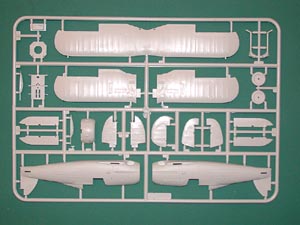 Roden's new Gladiator is a very good - not a great - kit. I really wanted it to be great like Tamiya's Swordfish or Accurate Miniatures' Grumman biplanes. I was predisposed to like it and so was unduly disappointed at its being only "very good" . So I dropped my intention of comparing it with Tamiya's and Accurate Miniatures' biplanes and switched my basis for comparison to the 37 year old Inpact kit of the Gladiator and, for more contemporary reference, to the Classic Airframes Curtiss P-6E, Boeing F4B-4/P-12E, Grumman Duck and Supermarine Walrus. Roden's new Gladiator is a very good - not a great - kit. I really wanted it to be great like Tamiya's Swordfish or Accurate Miniatures' Grumman biplanes. I was predisposed to like it and so was unduly disappointed at its being only "very good" . So I dropped my intention of comparing it with Tamiya's and Accurate Miniatures' biplanes and switched my basis for comparison to the 37 year old Inpact kit of the Gladiator and, for more contemporary reference, to the Classic Airframes Curtiss P-6E, Boeing F4B-4/P-12E, Grumman Duck and Supermarine Walrus.
Now - with my druthers, and prejudiced biases revealed - let's look at the kit itself. It comes in a stout enough, rather large, lidded box; none of those flimsy, pre-crushed, end-opening affairs we've been getting from the near east. Eighty nine parts are well molded, with very few sink marks, in a pale grey styrene. Five sharply molded clear parts comprising a three-part windscreen/hood, instrument panel and belly I.D. light complete the plastic content of the kit. There are no resin or photo-etched parts included in this kit. 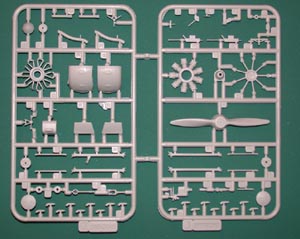 The instructions, contained in 12 well illustrated pages of slightly less than A4 size, include: A brief tri-lingual (Ukrainian, German and English) history with specifications, general instructions, color guide (referencing paints by Humbrol, Testors, Gunze and Lifecolor names and numbers), parts map, 16 step assembly sequence, five three-view color scheme drawings, rigging diagram and an ad for Roden's kit #405 - a Sea Gladiator and kit #401 - a Mk.II with ski option; both to be released in 2003. The instructions, contained in 12 well illustrated pages of slightly less than A4 size, include: A brief tri-lingual (Ukrainian, German and English) history with specifications, general instructions, color guide (referencing paints by Humbrol, Testors, Gunze and Lifecolor names and numbers), parts map, 16 step assembly sequence, five three-view color scheme drawings, rigging diagram and an ad for Roden's kit #405 - a Sea Gladiator and kit #401 - a Mk.II with ski option; both to be released in 2003.
Lamentably - to me - only one of the five color schemes is for a pre war silver winged Gladiator, that being K8036 of 33 Squadron in Palestine in early 1939. This is a very plain airplane completely bereft of the colorful squadron markings of the UK based airplanes of the period. The remaining four color schemes - all in the dark green/dark earth over black/white fighter scheme of the 1939-1940 period - are for L8009 of 809 Squadron in Egypt in 1940, K7995 of 607 Squadron in the UK in 1939, K6134 of 112 Squadron in the Sudan in late 1940 and L8011 of 80 Squadron in Amiyra, Egypt in early 1940. These five color schemes are provided for on the sharp, well printed, kit decal sheet. I had access to two kits for this review - one provided by the publisher of this magazine and one that I purchased from Squadron Mail Order for $23.96 (Why don't they quit this foolishness and simply price it at $24?). The decals in my kit were in perfect register; the decals in the publisher's kit had the bullseyes in the centers of the roundels slightly off center. Roden pack a separate small instruction sheet with the decals calling attention to the fact the instrument decals are reverse printed for application to the back side of the clear instrument panel. In addition to the national and squadron markings, the decal sheet includes extensive stenciling, the most unusual - and welcome - of which is Dunlop markings for the tires (tyres). I'll be photo-copying these and printing them in various appropriate sizes on decal stock for other applications such as the Swordfish. 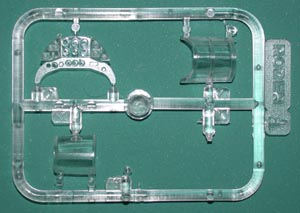 Engineering of the kit is conventional with two welcome exceptions; all the control surfaces are separate and the undercarriage joints are deep and of large contact area for strength. The top wing is one piece tip-to-tip and the bottom is in right and left halves. The fin, rudder, stabilizers, elevators and ailerons are all also molded in one piece. Typical of smaller kit manufacturers, there are no locating pins on the fuselage halves but there are deep fitting tabs of good area for locating the lower wing, the tailplane and the fin - no crude butt joints here. Engineering of the kit is conventional with two welcome exceptions; all the control surfaces are separate and the undercarriage joints are deep and of large contact area for strength. The top wing is one piece tip-to-tip and the bottom is in right and left halves. The fin, rudder, stabilizers, elevators and ailerons are all also molded in one piece. Typical of smaller kit manufacturers, there are no locating pins on the fuselage halves but there are deep fitting tabs of good area for locating the lower wing, the tailplane and the fin - no crude butt joints here.
Kit Minuses • Wing and tail rib detail is weak and there is no rib tape detail.
• Sink marks in the propeller face blade roots and on the external skin along the molded internal fuselage structural detail will require filling.
• Propeller rear face roots need a fair bit of reshaping for accuracy.
• The external, plate type, oil cooler molded integrally with the right fuselage half is very shallow and weak on detail.
• Cabane and interplane struts are marginally too narrow in chord and a bit crude at their ends.
• The interior detail, although more extensive than that of the Inpact kit, is much less than on a typical Classic Airframes kit and is not up to the state of today's art.
• The kit design engineer did not address simplifying top wing installation or alignment. All you get is four individual cabane struts and four individual interplane struts and it's up to you fiddle the top wing into proper alignment. Monogram, Hasegawa, Matchbox, Frog, Heller, Tamiya and Accurate Miniatures did a good job of making top wing alignment a piece of cake for the modeler and I'm sure their mastering and mold making was no more expensive as a consequence. Biplanes will be more attractive to a wider market and sell better if kit designers will intelligently address this problem in their future efforts. Advanced modelers will build an assembly jig to ensure the top wing is correctly aligned with the rest of the airplane but the less experienced may give up in frustration and buy no more biplanes. Kit Pluses • Control surfaces are all separate.
• Undercarriage/fuselage joints are really well engineered.
• Cockpit flap doors are separate.
• Stout enough, lidded box. 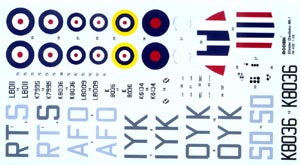 Items To Be Alert To Items To Be Alert To
• The kit provides a tropical carburetor intake filter for use as appropriate and nothing - correctly - for the non tropical airplanes covered by the kit decals. Beware; many Mk.I Gladiators had Mk.II non-tropical intakes fitted. Always check your references as well as your six.
• The underwing gun barrels WILL break off - replace them with barrels made from metal tubing.
• The cockpit fresh air intakes (parts 57D) inside the engine cowling need to be drilled out.
• Gladiators came from the factory with very nice, closely fitting fairings between the ends of the undercarriage struts and the inside faces of the internally sprung wheels. The kit does not provide these. You should also add the short length of brake hose between the struts and the wheels.
• The kit does not include the three visually prominent exhaust collector mounting struts that attach to the engine crankcase. These are easily made from wire.
• The nose of the fuselage is a bit too full where it tucks inside the engine cowling. It's a simple matter to correct with a bit of filing and sanding; check your reference drawings. Conclusion A very good - not a great - kit; quite buildable. I will kit-bash mine with an Inpact kit (or one of the reissues by Pyro, Lifelike, Hobby-Life and Lindberg) using the Inpact wheels/tires, oil cooler, and cabane and interplane struts. Roden deserve to have this kit be a good seller along with its soon to be release siblings. Now - Messrs. Roden, how about some more biplanes, A Boeing-Stearman perhaps or a DeHavilland Tiger Moth or an Fw. Stieglitz? I'm sure the manufacturers of aftermarket products will soon offer us resin, PE and decals in plenitude for this kit. Presently the only other items I personally know of for the Gladiator are a variety of decals. the Inpact, et al, kit contains decals for silver winged Mk.I K7985 of 738 Squadron at Digby in 1938. Replica Decals issued their sheet Z-4 back in the 1960s including markings for silver winged K6147 of 3 Squadron at Kenley in 1937 and camouflaged Sea Gladiator N5519 of 261 Squadron at Luqa, Malta in 1940 (putatively of Faith, Hope and Charity fame - see the History above). A few years ago Aeromaster released their sheet #48-187 for four camouflaged Gladiators: Pattle's Mk.I K7971 of 80 Squadron at Larissa, Greece in 1941, Sea Gladiator N5519 of 261 Squadron - Malta, Sgt. Valio Porvari's Finnish Mk.II, GL-264 of LeLv 26 at Joetseno in 1942 and J-8 (the Gladiator's Swedish designation) #15 of the Flygvapnet's Flygflottilj 19 volunteer unit at Kemi in northern Finland in 1942. Robert Allen, editor of our IPMS-Seattle newsletter advises that Max Decals sheet Max4801 has markings for Gladiator Mk.I #26 of the Irish Air Force and that Mike Grant Decals sheet 48-MG001 has markings for an Egyptian Mk.II, a Luftwaffe Mk.I, a Greek Mk.I, a Lithuanian Mk.I, and a Latvian Mk.I. The Warpaint book reviewed above also lists Tally Ho's sheet TH4207 with Finnish Air Force markings. Buy this kit and have fun. Better yet - buy several and have lots of fun. * Some sources say 746 Gladiators were built but being a Boeing guy I naturally prefer the number of 747. References • On Silver Wings - RAF Biplane Fighters Between the Wars: Alec Lumsden & Owen Thetford, Osprey Pubs., London, 1993, ISBN: 1-85532-374-5.
• Aeromodeller - December 1958: Famous Biplanes No. 18 Gloster Gladiator, C.A.G. Cox, short article with 1:48 scale drawings, detail sketches and photos.
• Aircraft Monograph - Gloster Gladiator: Francis K. Mason, MacDonald, UK, 1964. (Does any reader have a copy of this title they'd sell to me?)
• Profile Number 98 - The Gloster Gladiator: Francis k. Mason, Profile Publications, Ltd., London.
• Camouflage & Markings, RAF Northern Europe 1936-45, Gladiator, Gauntlet, Fury Demon: James Goulding and Richard L. Ward, Ducimus, London.
• Air Enthusiast - March 1973: A fine in-depth article on the Gladiator.
• Scale Models - August 1973: Gloster's Gladiator & A Portfolio of Scale Data for Modellers;many good detail photos.
• Airfix Magazine - January 1974: Fighting Colours 1914-1937, part 19: Guide to the Gladiator, Bruce Robertson.
• Flying - August 1976: Gladiator, James Gilbert, nostalgic article with many good color photos of Shuttleworth airplane.
• Scale Models - October 1978: Article on superdetailing the Matchbox kit.
• Scale Models - January 1980: Battle of Britain No. 5 - Building Gladiator Mk.II, N2308 of 247 Squadron from the Frog kit, Ray Rimell and Neil Robinson, good detail photos.
• Scale Aircraft Modelling - May 1981: Aircraft In Detail - Gloster Gladiator, Lindsey Peacock.
• Modelaid - Issue Unknown: Richard J. Caruana article on Faith, Hope & Charity. (Can any reader advise the issue?)
• Osprey Aircraft of the Aces - 44 - Gloster Gladiator Aces: Andrew Thomas, Osprey, UK, 2002, ISBN: 1-84176-289X.
• Mushroom Magazine Special: Yellow Series - Gloster Gladiator: Alex Crawford, Mushroom Model Pubs., UK, 2002, ISBN: 83-916327-0-9.
• Monographie Lotnicze No. 24 - Gloster Gladiator: B. Belcarz & R. Peczkowski, Poland. (Does any reader have a copy of this title they'd sell to me?) NB I have not listed the small William Green Fighters volume here as it is so long out of print and has nothing in it that is not covered in any of the above noted books. All of us old-timers have the "Little Green Books" but most of the younger enthusiasts have never even heard of them. Our thanks to Roden and Squadron for the review kits.
| 







|
 Roden's new Gladiator is a very good - not a great - kit. I really wanted it to be great like Tamiya's Swordfish or Accurate Miniatures' Grumman biplanes. I was predisposed to like it and so was unduly disappointed at its being only "very good" . So I dropped my intention of comparing it with Tamiya's and Accurate Miniatures' biplanes and switched my basis for comparison to the 37 year old Inpact kit of the Gladiator and, for more contemporary reference, to the Classic Airframes Curtiss P-6E, Boeing F4B-4/P-12E, Grumman Duck and Supermarine Walrus.
Roden's new Gladiator is a very good - not a great - kit. I really wanted it to be great like Tamiya's Swordfish or Accurate Miniatures' Grumman biplanes. I was predisposed to like it and so was unduly disappointed at its being only "very good" . So I dropped my intention of comparing it with Tamiya's and Accurate Miniatures' biplanes and switched my basis for comparison to the 37 year old Inpact kit of the Gladiator and, for more contemporary reference, to the Classic Airframes Curtiss P-6E, Boeing F4B-4/P-12E, Grumman Duck and Supermarine Walrus. The instructions, contained in 12 well illustrated pages of slightly less than A4 size, include: A brief tri-lingual (Ukrainian, German and English) history with specifications, general instructions, color guide (referencing paints by Humbrol, Testors, Gunze and Lifecolor names and numbers), parts map, 16 step assembly sequence, five three-view color scheme drawings, rigging diagram and an ad for Roden's kit #405 - a Sea Gladiator and kit #401 - a Mk.II with ski option; both to be released in 2003.
The instructions, contained in 12 well illustrated pages of slightly less than A4 size, include: A brief tri-lingual (Ukrainian, German and English) history with specifications, general instructions, color guide (referencing paints by Humbrol, Testors, Gunze and Lifecolor names and numbers), parts map, 16 step assembly sequence, five three-view color scheme drawings, rigging diagram and an ad for Roden's kit #405 - a Sea Gladiator and kit #401 - a Mk.II with ski option; both to be released in 2003. Engineering of the kit is conventional with two welcome exceptions; all the control surfaces are separate and the undercarriage joints are deep and of large contact area for strength. The top wing is one piece tip-to-tip and the bottom is in right and left halves. The fin, rudder, stabilizers, elevators and ailerons are all also molded in one piece. Typical of smaller kit manufacturers, there are no locating pins on the fuselage halves but there are deep fitting tabs of good area for locating the lower wing, the tailplane and the fin - no crude butt joints here.
Engineering of the kit is conventional with two welcome exceptions; all the control surfaces are separate and the undercarriage joints are deep and of large contact area for strength. The top wing is one piece tip-to-tip and the bottom is in right and left halves. The fin, rudder, stabilizers, elevators and ailerons are all also molded in one piece. Typical of smaller kit manufacturers, there are no locating pins on the fuselage halves but there are deep fitting tabs of good area for locating the lower wing, the tailplane and the fin - no crude butt joints here. Items To Be Alert To
Items To Be Alert To







